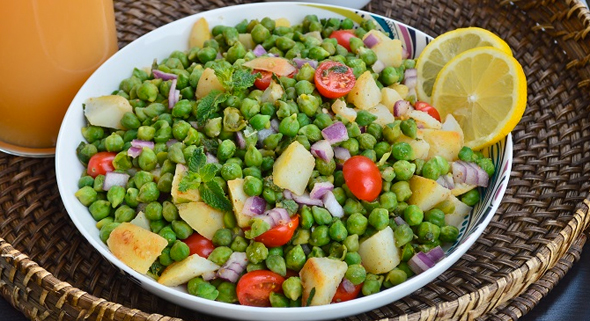Mama’s Punjabi Recipes: Choliya da Snack (Green Chickpea Snack)
Saved under Community, Current Stories, Recipe Corner
Tags: Baytown, Choliya da Snack, Clear Lake, Cypress, Desi news, Greater Houston, Green Chickpea Snack, Houston, Houston Desi news, India, Indian American community, Indian News, Indians in America, Indo-American News, Katy, Mama’s Punjabi Recipes, NRI, pearland, south asia, South India, Sugar Land, Texas, USA
Most young people in the US are familiar with safayd chole (white garbanzos or chickpeas) since they are served often at restaurants and private parties. Usually they are eaten with white rice or some form of roti (Indian flat bread). Boiled chickpeas are even served in many mainstream American restaurants as an item to be mixed in when creating your own salad. And of course, they are the main ingredient when making Mediterranean style hummus (ground chickpeas in oil and lemon with tahini or ground sesame seeds).
Fewer young people are aware of kale channe (black chickpeas) which are also appreciated by desis from the Old Country for their taste. They are small, hard and covered with a reddish brown skin and when compared to the white variety, much more flavorful, a better source of protein and easier to digest.
But relatively fewer young people know about the hara choliya (green young chickpeas) , also known as Punjabi choliya which first generation immigrants probably remember fondly. Choliya is available only during the winter season in north India when the sabzi walas (vegetable vendors) sell the long stalks of the plant. You simply have to shell them out and cook them as you want.
Choliya are the green, not yet mature chickpea, still in its pod and fresh, easy to chew and slightly earthy and nutty in taste. If you happen to be near a farm, you could pick it yourself and eat it like peas from a pod.
Since they are so popular in north India, choliya are now easily available in the frozen food section of Indian grocery stores. In fact, many people will shell them and freeze the choliya on their own.
They are rich in protein, carbohydrates, vitamin A and C, iron and are a good source of dietary fiber, just like regular chickpeas are, and do not contain any fat.
And there are several ways to cook choliya. Of course, the way to enjoy their uniquely fresh taste is as a light snack, much like a young bean sprouts salad, with a few other ingredients, to compliment and savor the taste of the choliya. You can even add other green vegetables that you want. It easy to make and healthy too!
Ingredients:
2 cups choliya (young green chickpeas)
5 cups of pani (water)
2 small aloo (potatoes) – red or white, do not use Russet
2 tbsp nimbu pani (lemon juice)
1 small piyaaz (onion)
Spices (to taste): namak (salt), mirch (red pepper), garam masala, amchoor (dried mango powder), ajwain (carom seeds)
Garnishes (to taste): hari mirchen (long green chillies), dhania (coriander), adrak (ginger)
Directions:
1. Wash the choliya well, then pour into a pot of water
2. Bring to a boil for at least 10 minutes under medium low heat.
3. Pour through a sieve and place the boiled choliya in a mixing bowl.
4. Boil the aloo till tender and drain the water. When cool, peel and chop into small pieces and throw into the bowl of choliya.
5. Finely chop the onions, chillies, dhania, and adrak.
6. Throw them into the bowl with the choliya and mix gently.
7. Add the salt, pepper, amchoor, garam masala, ajwain and squeeze in some lemon juice. Mix well.
8. Place in the fridge for 30 minutes before serving cold as an appetizer or a salad.
MAMA’S TIP OF THE WEEK
KEEP LETTUCE FRESH LONGER IN PLASTIC BAGS
For those who love to eat salads, it is important to keep all the ingredients fresh and crunchy. This is especially true of lettuce – whether the commonly available Romaine, green or red tip or butter – or any other leafy greens like kale or spinach which can easily get limp and wilted if kept directly in the fridge for too long.
The best way to store these greens is in the clear plastic bag that you use when buying them in the grocery stores. Simply tie the top off lightly in a knot and put them in the fridge, not necessarily in the crisper section. The lettuce and greens will stay fresh and crisp for as long as 10 days.

Shakuntla Malhotra is a skilled cook of Punjabi dishes made in the old-fashioned style that she learnt as a young woman in her ancestral home in Lyallpur (since renamed Faisalabad), India before it became part of Pakistan after the Partition in 1947. People have often admired her cooking for its simplicity and taste that comes with each mouthful. Even in her mid-eighties, she continues to cook daily and agreed to share some of her delectable Punjabi recipes

